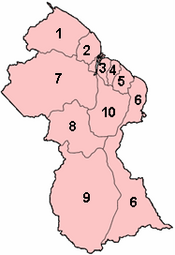Guyana is divided into 10 regions: [1] [2]
| No. | Region | Area (km2) | Pop. (2012) | Pop. per km2 | Capital |
|---|---|---|---|---|---|
| 1 | Barima-Waini | 20,339 | 26,941 | 1.3 | Mabaruma |
| 2 | Pomeroon-Supenaam | 6,195 | 46,810 | 7.6 | Anna Regina |
| 3 | Essequibo Islands-West Demerara | 3,755 | 107,416 | 28.6 | Vreed en Hoop |
| 4 | Demerara-Mahaica | 2,232 | 313,429 | 140.4 | Triumph [3] [4] |
| 5 | Mahaica-Berbice | 4,190 | 49,723 | 11.9 | Fort Wellington |
| 6 | East Berbice-Corentyne | 36,234 | 109,431 | 3.0 | New Amsterdam |
| 7 | Cuyuni-Mazaruni | 47,213 | 20,280 | 0.4 | Bartica |
| 8 | Potaro-Siparuni | 20,051 | 10,190 | 0.5 | Mahdia |
| 9 | Upper Takutu-Upper Essequibo | 57,750 | 24,212 | 0.4 | Lethem |
| 10 | Upper Demerara-Berbice | 17,040 | 39,452 | 2.3 | Linden |
| Guyana | 214,999 | 747,884 | 3.5 | Georgetown |
Each Region is administered by a Regional Democratic Council (RDC) which is headed by a Chairman. The Regions are divided into neighbourhood councils, known as Neighbourhood Democratic Councils (NDCs). [5]
Contents
- Historical divisions
- Regions of Guyana (1971)
- Regions of British Guiana (1958)
- Colonial counties (before 1958)
- Lands inhabited by Indigenous peoples
- See also
- References
- External links
The current regional structure was established by the Local Democratic Organs Act in 1980. The hyphenated names indicate the name of the rivers that define their border. [6]

